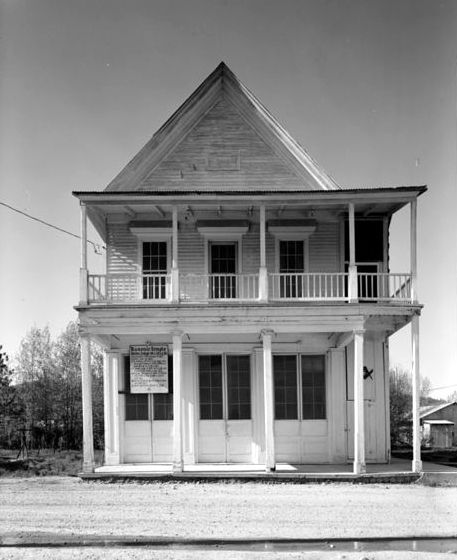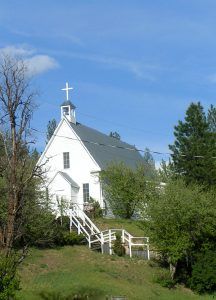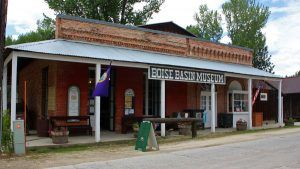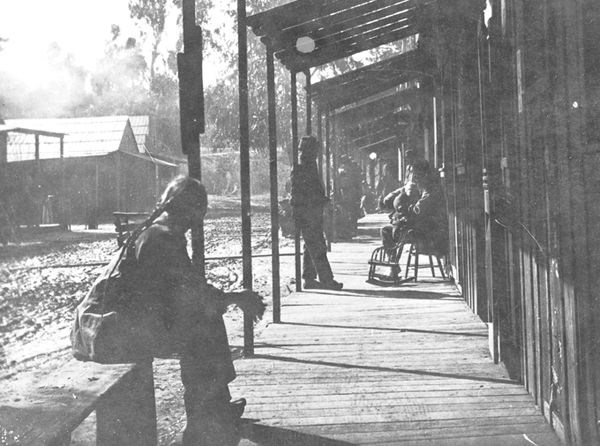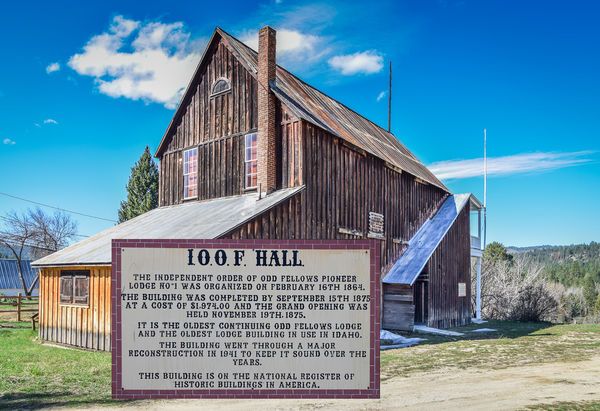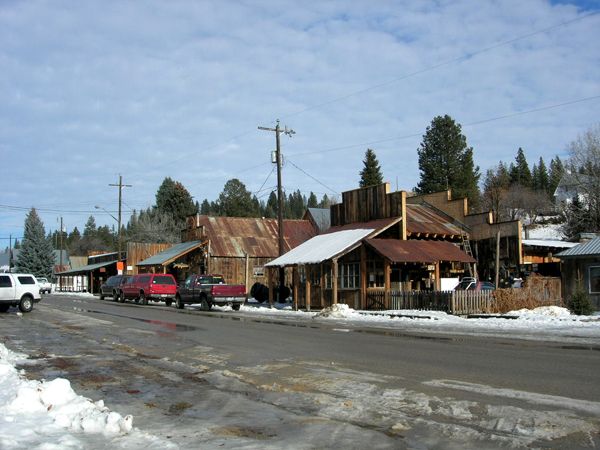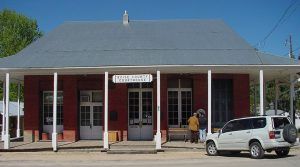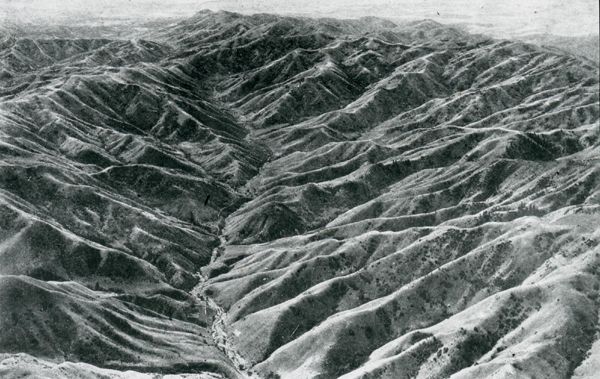
Boise Basin, Idaho
Idaho City, Idaho was once bustling with miners living in the largest town between St. Louis and San Francisco.
Following rumors of large goldfields to be found in southern Idaho, George Grimes and Moses Splawn were leading a small group of prospectors when they discovered gold in the Boise Basin on August 2, 1862.
It all started with a story told to Splawn a year earlier by an Indian who said that there was so much gold laying about that it could be picked up by the handfuls. The prospectors initially found some placer deposits in the Boise River, which they traced upriver to the creeks that flowed through the Boise Basin. These creeks would eventually be named Mores Creek and Grimes Creek.
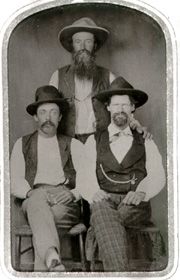
John Splawn at right in the mid-1880s
Here, they found the gold they were looking for. Unfortunately for Grimes, he was killed within just a few days of the find. Some say he was killed by a greedy partner, but the accepted story is that he was killed by Indians. His partners buried him in a prospect hole in a mountain pass, which is now called Grimes Pass.
The discovery party then returned to Walla Walla, Washington with $5,000 in gold and the news of the strike. In the fall they headed back to the Boise Basin with about 50 men. At this time, the area was a wilderness area inhabited only by the Indians. However, as word of the gold discovery traveled, this would quickly change and the gold rush was on. Many people traveled by steamer up the Columbia River to Umatilla, Oregon departing from Umatilla by stage lines, and finally journeying by pack-train to the Boise Basin.
The Boise Basin gold rush was the largest since the California gold rush a dozen years earlier. For a hard-working gold miner in a good location, a week of prospecting could yield $2000 per week. Within eight months of the strike, the area would become the largest settled area of the Pacific Northwest.
As the growing number miners began staking claims, a number of boomtowns erupted including Placerville, Centerville, Pioneerville, and Idaho City.
Situated along Grimes Creek, the first camp at what would become Idaho City was established by Captain Jeff Standifer. A town was officially founded on October 7, 1862, by J. Marion More, a member, of the Splawn-Grimes discovery party. The town was first called Bannock City. In March 1863 it took on the name of West Bannock, and in December 1863 it was changed to Idaho City by the new Idaho Territorial Legislature to avoid confusion with Bannack, Montana.
J. Marian More, the founder of the town, became very wealthy from his prospecting and eventually would own several mines around Idaho City. Later, he began buying mines in the Silver City area, where he was involved in the Owyhee Mine War which resulted in several killings. More, himself, would be shot down in Silver City in 1868.
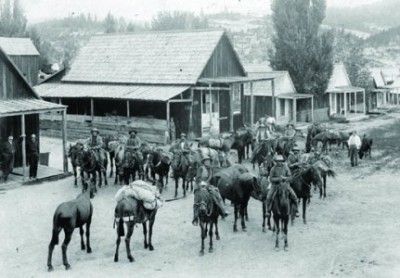
Historic Idaho City, Idaho
Although Placerville enjoyed the advantage of a location convenient to the point at which the gold rush entered the Basin, Idaho City boasted greater growth and prosperity because it had a better water supply. It quickly grew into more than just a mining camp. Readily available timber made it possible to build permanent structures quickly, turning the tent town into a flourishing city.
At the time of the gold rush, Idaho was still a part of Washington Territory and the Boise Basin was located in Idaho County, of which, Florence was the county seat. Because Florence was remote from the new mining basin, the Washington Legislature established Boise County on January 29, 1863. The Governor of Washington assigned William Noble, Frank More, and John C. Smith as commissioners and instructed them to establish the County seat at Idaho City. The first county officers besides the commissioners were Sheriff, Sumner Pinkham; Probate Judge Daniel McLaughlin; Auditor, W. R. Underwood; Treasurer, Charles Vajin; and Assessor George Goodman.
When Congress created Idaho Territory on March 4, 1863, Boise County exceeded the other counties in both area and in population. Those in office in Boise County retained their positions until the territorial government could be officially organized.
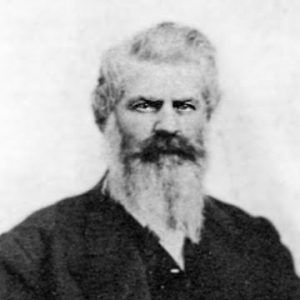
Sumner Pinkham
In August 1863 Sheriff Sumner Pinkham appointed Orlando “Rube” Robbins, who shared his political opinions, as his deputy. Robbins would later make himself known as one of Idaho’s greatest lawmen.
Before the community was a year old, Idaho City had 250 places of business including three express offices, three livery stables, a mattress factory, four sawmills, seven blacksmith shops, eight bakeries, nine restaurants, two bowling alleys, three pool halls, three drugstores, four breweries, and 20-25 saloons. Professionals included 15 doctors, 25 attorneys, and a photographer. The town also boasted two schools, a library, a newspaper called the Boise News, several churches, a hospital, and five community theaters. Building lots ranged in price from $500 to $2000 each.
Near the end of 1863, it was estimated that some 25,000 people were living throughout the hills, with 6200 of them living in Idaho City.
A substantial county jail building was erected in the winter of 1863-64. The facility was put under the immediate supervision of Sheriff Sumner Pinkham. It was completed before the first term of the District Court was held in March 1864. The hand-hewn prison was originally erected above Elk Creek, north of Idaho City. It had fourteen cells, chains, doors lifts, and window irons that were used to discourage escape. It was erected at a cost of $8080 in gold dust, the then currency in the region. The same year, the Territorial Legislature designated the city jail as a territorial prison, for which it would serve as for the next eight years. Much of the original Idaho City jail fell into Elk Creek when gold diggers undermined the area in the early 1900s. The remaining buildings were moved into Idaho City where they continue to today.
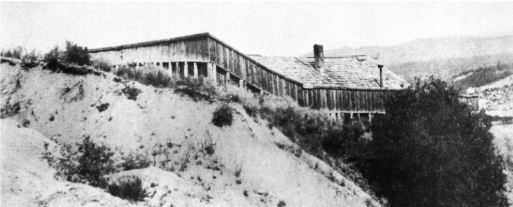
Territorial Penitentiary in Idaho City, Idaho.
The Idaho Territorial Legislature officially “re-established” Boise County on February 4, 1864, with Idaho City remaining as the county seat. The county was one of four Idaho counties that also existed under Washington Territory. On February 27, 1864, the Boise News announced that the governor had appointed the following county officers: John C. Smith, Frank Moore and Henry I. Crow, commissioners; Sumner Pinkham as sheriff; Daniel McLaughlin, probate judge; Washington R. Underwood, auditor; and Charles D. Vajen, treasurer, all of whom were to hold their positions until an election was held in the Fall.
On June 22, 1864, Idaho City’s first post office was established on Main Street. Other events occurring in 1864 were: the Boise News changing its name to the Idaho World, wagon roads to the community were built, and the sawmill ran continuously with rough lumber.
During these early years, Idaho City had assumed reputation of being the best mining camp in the Basin, the general rendezvous point of miners, speculators, and gamblers, and the hub of territorial commerce. It also attracted families as it offered special appeal to those seeking homes, plus it boasted two schools and a library. More children and women were in evidence here than in most other mining camps.
But of all the communities, Idaho City was said to have been the bawdiest and lustiest of the Boise Basin’s offspring. There was certainly a rough-and-tumble aspect to Idaho City. Bar fights and murders were prevalent. Stealing horses, robbing stages, and killings were common in the area as bands of desperadoes came into the gold camps.
With the Civil War raging in the East, the Boise Basin miners polarized around the Union and Confederate causes. Fueled by whiskey, Northern and Southern sympathizers often bloodied one another with fists, knives, and sometimes guns as they used force to show their opinions. Many an evening, Sheriff Sumner Pinkham and his deputy Rube Robbins had to lock up a drunken loudmouth who was threatening to punch or shoot to demonstrate his political beliefs to an equally intoxicated opponent.
On one occasion the Idaho World reported: “Several parties were found in the streets on Tuesday morning. Some with fractured skulls; some with bunged eyes and swollen faces, indicating very clearly that there had been a muss somewhere during the night. Blood was freely sprinkled about the town on woodpiles and sidewalks. As the puddles of blood were distributed over a large district, it was impossible to locate the fight.”
In the meantime, Sheriff Sumner Pinkham did his best to tame the lawless town.
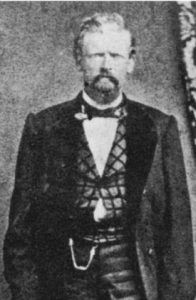
Ferd Patterson
With his staunch Unionist views, Republican politics, and tough law enforcement, Pinkham soon made himself many enemies in the predominately Democratic Boise County. However, both Pinkham’s enemies and his most loyal friends were quick to admit that he was a man not to be trifled with when he undertook to enforce the law, which he did so with an iron hand. One of his most fervent enemies was a Southern gunfighter by the name of Ferdinand “Ferd” Patterson.
In the Autumn of 1864, Pinkham was running for re-election as Boise County Sheriff. In a bitterly contested between the Democratic successionists and Republican candidates, Pinkham, an outspoken Union supporter, was defeated by A.O. Bowen by a comfortable majority.
As the last of the ballots were being counted, Ferd Patterson was celebrating when he encountered his old nemesis Sumner Pinkham, who was in a rage. Wasting no time, the lawman took a swing at Patterson, hitting him in the jaw, throwing the gambler off the street and into the gutter. Then Pinkham walked away. Locals expected immediate retaliation from Patterson but it did not occur.
After losing the election Sumner left Idaho City to visit his dying mother in Illinois.
By the end of the year, the town’s population of 7,000 surpassed Portland, Oregon in size, making it the largest community in the Pacific Northwest.
The winter of 1864-65 was severe and the snows and cold were followed by heavy rains. The roads were impassable and pack trains could not get through. The early Spring of 1865 saw a large immigration into the Boise Basin before supplies were brought in. The increased population and scarcity of provisions precipitated a food riot. There was no starvation but the prices were high. Flour sold for $1 a pound. Street meetings were held, incited by those who had recently arrived.
A mob of 60 men went to some of the stores in Idaho City and seized the supplies. Jack Gorman, a deputy sheriff, arrested and disarmed the leader, a big man from Missouri, and placed him in irons, despite the threats of the rioters. In a short time order was restored, the merchants reduced the price of flour and soon, with the incoming pack trains, there was an abundance of all necessities.
On the night of May 18, 1865, disaster struck Idaho City. A fire erupted about 9:00 p.m. near the center of town, believed to have started in the upper story of a dance hall. Since all of the buildings were made of pine, the fire moved swiftly. Miners from all over the Basin came running into town when they saw the sky lighted by the fire. Looters took what they could carry from stores before they were engulfed in flames. The fire lasted about three hours destroying most of the businesses and better residence parts of the town. Many men who had been considered wealthy were left penniless though some merchants who had underground cellars were able to salvage a few items.
Of the public buildings, only the Catholic Church, the Jenny Lind Theater, the office of the Idaho World, and the I.O.O.F. Hall remained standing. The homeless were housed in homes that escaped the flames and the Catholic Church was converted into a hospital. The loss was estimated at $900,000. An indictment of arson was found against one man, but the matter was later dropped.
The townspeople immediately began rebuilding and a few weeks later business activities were being carried on as before.
One of the new structures that were built that year was the Masonic Temple, known as Lodge #1 of Idaho’s Ancient Free and Accepted Masons. it was completed in October 1865 after James Pinney, a Mason himself, received permission to build the new structure. Idaho Lodge #1 moved its meetings to Boise in the 1920s, but its occasional use of the building makes the structure the oldest Masonic Temple this side of the Mississippi River still in use today.
In the meantime, ex-sheriff, Sumner Pinkham had returned to Idaho City and the locals immediately began to speculate that Pinkham and Ferd Patterson were going to have it out.
After the Civil War’s end, Sumner Pinkham staged a gala Fourth of July party. The crowds were mostly in a festive mood with fireworks blazing and booze flowing. The celebration included a brass band, speeches, patriotic songs, a picnic, and Sumner Pinkham leading the parade through town. For the victorious Yankees, it was a proud day. But, for the sullen Confederate sympathizers, it was not so much, as they heckled the “Blue Bellies” throughout the day. For Ferd Patterson, seeing Pinkham leading the parade, was a further stab at his southern loyalties.
Pinkham was singing “Oh, we’ll hang Jeff Davis to a sour apple tree!” Ferd Patterson yelled out to Pinkham that if he didn’t shut his mouth he’d shut it for him. Pinkham invited him to try and he did. A brief scuffle between the two men resulted in the flag falling into the dust of the street. Some witnesses later swore they saw Ferd Patterson spit on it and others swore they heard Pinkham swear he would kill Patterson for that.
Several weeks later on Sunday, July 23rd, Ferd Patterson shot and killed Sumner Pinkham at the Warm Springs Resort about two miles west of town. Witnesses reported they heard Patterson say the word “draw” and then taunted Pinkham by calling him an “Abolitionist son-of-a-bitch.”
Patterson quickly fled but was captured, returned to Idaho City, and tried for the murder. But, he was quickly acquitted, prompting the Oregon newspaper to report:
“This ruffian has gone through the farce of a trial by a jury of fellow “Democrats” at Idaho City, and of course, has been acquitted. By those who know the character of Patterson and his associates in Idaho, no other verdict was anticipated.”
Previous to the killing of Pinkham, who was regarded as the leader of the loyal element of the Boise Basin society, no vigilance committee had existed within the precincts of the mining district. However, the trouble between Patterson and Pinkham and threats made by desperate characters to burn the town, a meeting was called by C.S. Kingley, the Methodist preacher, and the businessmen of Idaho City. A local blacksmith was chosen as the captain and the organization soon had several hundred members.
Two years after Idaho City’s first fire, almost to the day, Idaho City was again the victim of an equally devastating fire in May 1867. All the hotels, the post office, express office, and many of the principal business places were consumed, with losses estimated at over a million dollars. For the second time the Jenny Lind Theater and the office of the Idaho World, which was in the Masonic building, were saved. This time, however, the St. Joseph Catholic Church and its nearby convent were destroyed. The present building was rebuilt in November. It continues to stand today with some of the vestments and altarpieces rescued from the fire still inside.
One of the buildings that suffered damage in the fire was the Boise Basin Mercantile located on the northeast corner of Main and Commercial Streets. The store was originally built in 1865. In its rebuilding, every effort was employed to guard against future fire damage, including a brick façade, iron doors and windows, and dirt packed into the attic. Another building was built next to it in 1868, and a third in 1869. Today these three separate buildings serve as the Boise Basin Mercantile. Fire has never again invaded this building, making it the oldest mercantile in Idaho.
It took Postmaster James Pinney only 29 days to build the Montgomery Street post office after the fire destroyed the first one on Main Street. Pinney lived in part of the building and in addition to selling stamps, he sold books, musical instruments, pistols, magazines, knives, and toys and operated a circulating library. After Pinney resigned as postmaster in 1872, the building housed a meat market and later the Idaho World newspaper. It remained a post office until 1910. Today it serves as the Boise Basin Museum located at 503 Montgomery Street.
Another building established in 1867 was the Pon Yam House at the corner of Montgomery Street and Commercial Streets. Pon Yam was a skilled goldsmith, successful businessman and a respected leader in the community. It was reported he owned the largest diamond in the mining camp, and he was often called upon to settle disputes among the Chinese Tongs. From this building, he sold herbs and other Chinese products until 1885. It is the only remaining building from Idaho City’s large Chinese population, today serving as a Chinese Museum and Cultural Center.
A famous political battle occurred in Idaho City on June 17, 1870. Congressman E. D. Holbrook and a gambler named Charles Douglass met one evening at the corner of Wall and Main Streets. After Holbrook called Douglass “a liar, a coward, and an assassin,” both men drew their guns. Eleven shots were fired. Holbrook was taken to his law office with several bullet holes in his abdomen. The next morning he was dead. Douglass escaped and was never heard from again.
In the early 1870s, the easily-worked basin stream gravels had yielded most of their gold and miners shifted their attention to washing down higher bench placers with hydraulic equipment. To get water to the elevation needed to cut down the hillsides, extensive systems of flumes and ditches were built. Some of these ran eight to ten miles in length.
In the meantime, many of the placer mining claims were sold to Chinese miners, who were willing to work the lower grade claims.
In 1875, I.O.O.F. Hall, Pioneer Lodge N. 1 was rebuilt since the original one had burned in the fire of 1867. This time the Odd Fellows built their structure on a hillside overlooking the city in the hope of protecting it from a fire. The two-story, wood-frame building was constructed at a cost of $1,974.00. The upper floor was used for lodge meetings and the ground floor for social gatherings. Pioneer Lodge No. 1 was originally established on April 16, 1864, making it both the oldest continuing lodge and the oldest lodge building in the State of Idaho.
Unlike some fabulous placer booms which went through a quick cycle from gold rush to ghost town, mining in the Boise Basin lasted for several decades, with Idaho City as the center of a major gold-producing region,
It is estimated that more than $250,000,000 was taken from this area in the two decades following its discovery.
In about 1900, economic diversification led to the use of Boise Basin timberlands. When the Intermountain Intermountain Railway was completed in 1915 from Boise to Centerville, timber rather than mining undergirded the region’s economy.
From 1919 until 1926, mining was limited largely to lode properties. Idaho City’s population fell to 104 by 1920.
Dredge mining which began in 1898 continued until 1952.
Today, the once mining bustling mining camp relies mainly on tourism, though with high price of gold, many of the old mines are active once again. The town’s current population is about 460 residents.
Visitors can enjoy a number of historic buildings and sites throughout the picturesque town. Some of these include the 1867 St. Joseph’s Catholic Church, the 1865 Masonic Temple, the 1867 Pon Yam House, the Idaho City Hotel built in 1929, the 1867 Idaho World Newspaper building, and many others.
One of the most interesting buildings in Idaho City os the Boise County Courthouse located at Main and Wall Streets. Construction on this building was begun in July 1873 and completed in October 1873. After the earlier fires in the community, the building was built with fire protection in mind. The great iron folding doors, each weighing half a ton, were made in San Francisco, barged up the Columbia River, and carried overland by horse and ox teams. Three feet of packed earth filled the attic space and local clay bricks and mortar finished the walls.
The brick structure was built as a general store operated by the Reverend C.S. Kingsley, a Methodist minister and a successful businessman. Kingsley was well known in Idaho City, having preached the first sermon in Idaho City before a large crowd gathered in the union hall in 1863. In 1865 he organized the first meeting of the local vigilante movement.
Of the buildings constructed during this time, none were greeted with more fanfare than Kingsley’s new brick store.
A “Mechanic’s Ball” marked the grand opening of the new store which the Idaho World described as “one of the largest and most commodious fireproof buildings to be found this side of Portland…” The newspaper also deemed the ball, which was attended by approximately 70 men and 35 women, as a “huge success.”
Kinglsey sold the store in 1880 to John Kenally, a miner, tinsmith, and merchant, and was used as a hardware store. Later, the building was rented to Alex and Mary Orchard who converted it into the Ochard Hotel.
In 1909, Boise County bought the building for $1,000 and changed it into a courthouse. The original offices of the Boise County Courthouse were housed in a pine frame building that still stands on Montgomery Street, now used as storage quarters for the county equipment. Today the building still functions as a courthouse.
Another interesting stop is the Old Pioneer Cemetery, sometimes referred to as Boot Hill. Established in 1863, there are said to be over 2000 people buried here, including hundreds of unknown or unmarked graves, many a result of the violence at this 1860s Gold Rush town. Of the first 200 graves, only 28 were for people who died of natural causes. Approximately 200 grave markers still stand in the cemetery that was originally sectioned off to accommodate the Masonic and Odd Fellows Societies, the Catholics, and the Chinese. The Masonic part is just a small area of the main cemetery. Most all Masonic tombstones were lost in a fire. The ground was set aside back in 1864 and has never changed. The Cemetery is located just northeast of town.
Historic Idaho City is located 45 miles northeast of Boise on Highway 21.
© Kathy Weiser-Alexander, updated June 2020
Also See:
Ferd Patterson – Living and Dying by the Gun
Ghost Towns of the American West
Sumner Pinkham – Dead at the Hands of a Gunfighter
Sources:
French, Hiram Taylor; History of Idaho: A Narrative Account of Its Historical Progress, Volume 1

